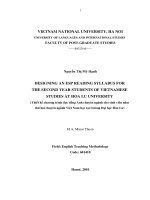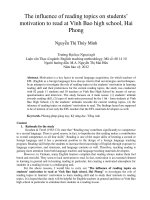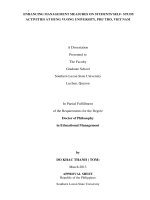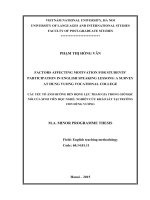Enhancing management measures on students self study activities at hung vuong university
Bạn đang xem bản rút gọn của tài liệu. Xem và tải ngay bản đầy đủ của tài liệu tại đây (334.87 KB, 84 trang )
ENHANCING MANAGEMENT MEASURES ON STUDENTS’ SELFSTUDY ACTIVITIES AT HUNG VUONG UNIVERSITY
___________________________
A DISSERTATION
Presented to the Faculty of the Graduate School
Southern Luzon State University, Lucban, Quezon, Philippines
in Collaboration with
Thai Nguyen University, Socialist Republic of Vietnam
___________________________
In Partial Fulfillment
of the Requirements for the Degree
Doctor of Philosophy in Educational Management
___________________________
By
DO KHAC THANH (TOM)
October 2014
i
APPROVAL SHEET
ii
CERTIFICATE OF ORIGINALITY
iii
ACKNOWLEDGMENT
The researcher wishes to convey his gratitude to the following persons who
wholeheartedly devoted and helped make this piece of work a reality:
DR. TERESITA V. DE LA CRUZ, his adviser for the guidance, supervision,
suggestions and precious time in enthusiastically reading and checking the
manuscript, providing the researcher useful materials;
DR. CECILIA N. GASCON, President of the Southern Luzon State University in the
Republic of the Philippines, for her incomparable contribution and support to
the Thai Nguyen University;
DR. NGUYEN VAN BINH, Director of the International Training Center, Thai Nguyen
University of Socialist Republic of Vietnam, for his enormous pursuit to
provide Vietnamese people an opportunity to grow through education;
DR. SUSANA A. SALVACION,DR.RICARYL CATHERINE P. CRUZ, DR.
APOLONIA A. ESPINOSA, and DR. BELLA R. MUELLO, panelists, for
constructive criticism and valuable comments and suggestions to improve the
study;
The ADMINISTRATORS, FACULTY and STUDENTS of the departments in the
Hung Vuong University in Vietnam, for their cooperation and support during
the conduct of the survey;
Teachers-respondents, for their active involvement and participation for without
their cooperation, the result of this thesis might not be possible;
His family and friends, for the love and support in one way or another; and to all
who have contributed to make this study a success.
DKT
iv
DEDICATION
This is whole-heartedly dedicated
To my family and relatives,
To my colleagues and friends,
and to all my classmates.
DKT
v
TABLE OF CONTENTS
PAGE
TITLE PAGE ………………………………………………………………..
i
APPROVAL SHEET ……………………………………………………….
ii
CERTIFICATE OF ORIGINALITY ………………………………………..
iii
ACKNOWLEDGMENT …………………………………………………..
iv
DEDICATION ………………………………………………………………
v
TABLE OF CONTENTS …………………………………………………..
vi
LIST OF TABLES ………………………………………………………….
viii
LIST OF FIGURES…………………………………………………………
x
LIST OF APPENDICES …………………………………………………...
xi
ABSTRACT …………………………………………………………………
xii
CHAPTER
I
II
III
INTRODUCTION ……………………………………………
1
Background of the Study …………………………………..
2
Objectives of the Study …………………………………….
4
Significance of the Study …………………………………..
5
Scope and Limitation of the Study ………………………..
6
Definition of Terms ………………………………………….
7
REVIEW OF LITERATURE ……………………….……….
10
Conceptual Framework …………………...….………..……
24
Research Paradigm ……………………………...….………
25
METHODOLOGY ……………………………………………
27
Locale of the Study ………………………….………………
27
Research Design …………………………….………………
27
Population and Sampling ………………….…...…………..
28
Instrumentation………………………...…………..…….….
29
Validation of the Instrument ………………………………...
30
Statistical Treatment …….…………………………………..
30
vi
IV
V
RESULTS AND DISCUSSIONS ……………………….….
32
Status of Self-Study Activities ……………………………...
32
Factors that may Affect Students' Self-Study Activities …
40
Management Measures for Self-Study Activities ………...
42
Proposed Strategic Development Program ………………
46
Proposed Management Measures of Self-Study Activities
48
SUMMARY, FINDINGS, CONCLUSIONS AND
RECOMMENDATIONS
Summary …………………..…………………………………
51
Findings…………………….………..…………………….…
52
Conclusions ……………………………………………….…
53
Recommendations ……………………………………..……
54
REFERENCES ……………………………………………………………..
55
APPENDICES ……………………………………………………………...
58
CURRICULUM VITAE …………………………………………………….
69
vii
LIST OF TABLES
TABLE
PAGE
1
Frequency, Percentage and Distribution of the Respondents
28
2
Frequency and Percentage Distribution of the StudentsRespondents ……………………………………………………..
29
Frequency and Weighted Mean Distribution on the Status of
Students’ Self-study Activities in terms of Awareness on
Self-study …………………………………………………………
32
Frequency and Weighted Mean Distribution on the Status of
Students' Self-study Activities as to Study Skills.....................
33
Frequency and Weighted Mean Distribution on the Status of
Students' Self-study Activities as to Students' Habitsduring
Self-study ...............................................................................
34
Frequency and Weighted Mean Distribution on the Status of
Students' Self-study Activities as to Services for Self-study
Support ...................................................................................
35
Frequency and Weighted Mean Distribution on the Status of
Students' Self-study Activities as to Teaching Initiatives ........
36
Frequency and Weighted Mean Distribution on the Status of
Students' Self-study Activities as to Self-study Location ........
37
Frequency and Weighted Mean Distribution on the Status of
Students' Self-study Activities as to Administration ................
39
Frequency and Weighted Mean Distribution of the Factors
that Affect Students' Self-study Activities as to External
Factors …………………………………………………………….
40
Frequency and Weighted Mean Distribution of the Factors
that Affect Students' Self-study Activities as to Internal
Factors …………………………………………………………….
41
Frequency and Mean Distribution of the Management
Measures of Self-study as to Planning ………………………..
42
Frequency and Mean Distribution of Management Measures
of Self-study as to Organizing the Orientation for Self-study
Activities …………………………………………………………..
43
3
4
5
6
7
8
9
10
11
12
13
viii
TABLE
14
15
PAGE
Frequency and Mean Distribution of Management Measures
of Self-study as to Organizing Management Activities for
Self-learning Skills Enhancement ……………………………...
44
Frequency and Mean Distribution of Management Measures
on the Use of Facilities and Equipment for Self-study
Activities …………………………………………………………..
45
ix
LIST OF FIGURE
FIGURE
1
PAGE
Input-Process-Output (IPO) Model on Enhancing
Management Measures on the Students’ Self-Study
Activities at Hung Vuong University …………………………...
x
26
LIST OF APPENDICES
APPENDIX
PAGE
A
Communications ……………………………………………..
59
B
Instrument …………………………………………………….
62
xi
ABSTRACT
Title of Research
: ENHANCING MANAGEMENT MEASURES ON
STUDENTS’ SELF-STUDY ACTIVITIES AT HUNG
VUONG UNIVERSITY
Researcher
: DO KHAC THANH (TOM)
Degree Conferred
: DOCTOR OF PHILOSOPHY IN EDUCATIONAL
MANAGEMENT
Name and Address
of Institution
: Southern Luzon State University Lucban, Quezon,
Philippines and Thai Nguyen University, Socialist
Republic of Vietnam
Adviser
: Dr. Teresita V. de la Cruz
Year Written
: 2014
______________________________________________________________
This study focused on enhancing the management on students' self- study
activities at the Hung Vuong University with an end view of developing management
measures of activities for school year 2013- 2014. Specifically, it sought to determine
the status of the self-study activities of students in terms of students' awareness of
the self-study, study skills, habits, services, teacher initiative, location, and
administration; find out the external and internal factors that affect activities of
students' self-study; identify the different management measures of self-study
activities as to planning, organizing the orientation and self-learning skills
enhancement, and managing facilities and equipment for students’self-study
activities; and develop strategic management measures for students’ self-study
activities. This study was conducted in Hung Vuong University were the survey was
done in eight academic departments and two administration divisions. It made use of
descriptive type of research wherein management of the self-study activities at Hung
Vuong University is being described as basis for proposing strategic management
measures for the self-study activities. There were a total of 206 faculty members and
administrators and 328 students selected as respondents through the stratified
xii
sampling. Meanwhile, the weighted arithmetic mean was used in analyzing the data
gathered. Thus, it was found out that students' awareness on self-study with 3.12
average weighted mean and qualitative description of “Aware”; self-study activities
help them develop their study skills as manifested in the average weighted mean of
3.32 (strongly agree); students sometimes develop study habits in doing self-study as
seen in 3.19 AWM; respondents strongly agree that services are provided for selfstudy (3.27); teaching initiatives for self-study (3.31); students sometimes designate
the location for their self-study (2.77); and administration of self-study activities gains
3.02 AWM described as carried out. Both external and internal factors greatly affect
the self-study activities of the students (both 3.29). The different management
measures of the self-study activities are always carried out as to planning
management of self-study (3.55), organizing the orientation (3.59) and the selflearning skills enhancement (3.55) and managing facilities and equipment (3.54). A
strategic management measures for students’ self-study activities has been
developed. It was then concluded that self-study activities of students have
commendable condition as it is known among students, likely improves self-study
activities and study habits, and are supported by the definite school services,
teaching
methodologies,
location
and
administration.
However,
it
is
still
recommended that self-study activities may be strengthened in order to promote
independent learning among the students and policies may be formulated to
formalize self-study program not only in the respondent school but also in other
institutions within the country.
xiii
1
Chapter I
INTRODUCTION
Entering the twenty-first century and the breakthroughs in all areas of
social life, human beings are faced with drastic changes of modern civilization
due to the innovations in science and technology. Education, in particular, is
considered a key factor for the development of the society. With the explosion
of information technology, the amount of human knowledge is increasing day
by day. Considering that the time for learning in the school is limited, students
should be equipped with self-study to acquire the knowledge needed and
demanded by the present society. By means of self-study, learners can study
regularly, practice lifelong learning anywhere and anytime.
To improve the quality of human resources for the industrialization and
modernization of the country, the Party and the State consider education as a
top national policy. Thus, the investment for education is an investment for the
development.Education has been an important driving force for the economic
and social development of the country for it determines the quality of human
resources. To improve the quality of education, the two elements of teaching
and learning must be focused on. In the process of learning, students must
bedirected
along
with
a
self-awareness,
positive,
proactive
self-
organizationand self-control of their own learning activities which could make
the educational process become a self-education process or self-study.
For the level of higher education, pedagogy requirements in Article 40
of the Vietnamese Law on Education (2005) states that methods of training
college and university degree shall be serious about fostering a sense of self-
2
learning ability, self-study, the development of creative thinking and practical
skills enabling students to participate in research, experiment and application.
Thus, self-study has great significance for the students themselves to
complete their learning tasks with the quality and efficiency. Self-study is the
most complete expression of the possible role in the cognitive processes of
students. In the process, the students must be active and independent, selfexploratory and discoverer to acquire knowledge under the direct control of
the teacher. However, to help the students achieve good study results, many
factors, both external and internal, are involved. The management of school/
organization/ university, in particular, is considered the most important
factor.With that, the study on enhancing management measures on students'
self-study activities at Hung Vuong University was conducted.
Background of the Study
In the learning process, self-study is justified as learning by students’
way so as to dominate the intellectual mind. Self-study has an important role
and strong impact on learning outcomes of students. There were researches
on the topic, but, accordingly, overall achievement is the work of the school. In
the learning process, the learners need to dominate their own knowledge and
skills, to master the trend and requirement of future career. Hence, initiative,
creativity and self-discipline are potent factors to be considered in self-study
method which will surely increase the efficiency of learning – the targeted goal
of the study.In students’ self-learning process, aside from the autonomy, selfawareness, the use of management measures on students' self-study,is also
to be considered. Self-study in the context of the chosen locale is similar with
3
modular instruction, however, the difference is there is less formal evaluation
on self-study in Vietnam, rather it is more particular with the time or schedule
allotted to students to have their self-study.
Hung Vuong University was established in 2003 on the foundations of
the PhuTho Teachers College. Over many years, it has made great efforts in
training teachersfor PhuTho province. From 2004, it was assigned tothe
disciplinary higher education. New in the field, theuniversity’s initial difficulties
were teaching and learning in higher education level. Most students who
justpassedthe entrance examination do not have established and active
habits of self-study and the necessary self-learning skills. Additionally, factors
such as physical facilities, books and curricula for the teaching and learning
are still insufficient for training which greatly affected quality of the school.
Based on roadmap innovation for higher education in Vietnam, Hung Vuong
University, from 2010, has transformed from a school-based to credit-based
system. With this change, the role of the students is set to the maximum with
the support of faculty and school management. However, it is still observed
that students of the university are having a hard time focusing on their
academics.
In standard practices of self-study, students ought to set realistic goals,
find what strategies work for them, review material as much as possible, the
same day they learn it, study in short, frequent sessions, and prepare and
maintain study environment. However, the predicaments in light of the actual
students’ self-study activities are characterized by their maladjustments tothe
workload according to how hectic their schedule is in any given week, and
giving themselves a mental break. Added to these are reviewing difficulties in
4
long-term absorption of material which results tofrequent cramming, breaking
up the material by topic into a series of short sessions, and creating a study
space for themselves. Though the foresaid standards are also the premise
followed in self-study model set for Hung Vuong University, still the mentioned
dilemmas continuously recur making students less likely see self-study as a
useful tool to enhance any learning experience, and when mastered, students
young and old reap the benefits.
Believing that whether applied to studying for examination or exploring
new material independently due to sheer curiosity, self-study can lead to new
opportunities academically and professionally, and being aware of the above
problems, the researcher deemed it necessary to identify the management
measures ofthe students' self-study activities at Hung Vuong University as a
matter of urgency to improve quality of its training. Moreover, in improving the
students' self-study activities, the strategic management measureis seen as a
significant response.
Objectives of the Study
This study focused on enhancing the management on students' selfstudy activities at the Hung Vuong University with an end view of developing
management measures of activities for school year 2013- 2014.
Specifically, it sought answer to the following questions:
1. Determine the status of the self-study activities of students in terms of:
1.1 Students' awareness on self-study,
1.2 Study skills,
1.3 Habits during self-study,
5
1.4 Services for self-study,
1.5 Teachinginitiatives,
1.6 Self-study location, and
1.7 Administration.
2. Find out the factors that may affect the students' self-study activities as
to:
2.1. External factors, and
2.2. Internal factors.
3. Identify the different management measures of self-study activities as
to:
3.1 Planning the management of self-study,
3.2 Organizing the orientation for self-study activities,
3.3 Organizing activities for self-learning skills enhancement, and
3.4 Managing facilities and equipment for students’self-study activities.
4. Develop strategic management measures for students’ self-study
activities.
Significance of the Study
This study would be beneficial to the students, teachers, administrators
and future researchers in the following respect:
Students. They will be benefited through this study since they are the
main concern ofthe educators and any endeavor to improve the management
of the self-study program could create positive effect on their activities. On the
other hand, in modern times that the increasing number of new technologies
and an expanding global population is evident, self-studying being on the rise
6
is helpful among the students since education is no longer confined to just the
classroom. Self-studying anytime and anywhere meets the intellectual needs
of individuals in such an interconnected society.
Teachers.The outcome of the studywill be of great help toteachers
because they would be made aware of the factors affecting the activities of
students' self-study. It would also guide teachersin assigning students with
projects and material suitable for self-learning, so that they may exercise and
develop intellectual independence and explore subject matter they personally
find interesting.
Administrators. It is hoped that the study may contribute in giving a
new dimension in administration of students' self-study activities. It may likely
aid administrators in enhancing program that couldpromote students’ initiative
in their school curriculum by exploring academic interests on their own.
Future Researchers. This study could provide references for future
proponents who wish to venture a study similar to the nature of the present
research. It may also open many avenues for the future researchers to work
on discovering the dynamics of self-study in the academe.
Scope and Limitations
The scope of the study was on enhancing the management measures
of the students' self-study activities at Hung Vuong University in the PhuTho
Province. The parameters for assessing the status of self-study activities are
students' awareness on it, study skills, habits during and services for selfstudy, teacher initiative, self-study location, and administration. The study was
also limited to finding out the external and internal factors that may affect the
7
activities of students' self-study and the relationship between the activities and
the factors. Likewise, the study focused on identifying different management
measures of self-study activities as to planning, organizing orientation for selfstudy and management activities for self-learning skills enhancement, and
managing facilities and equipment for students’self-study activities. These
become basis for developing strategic management measures for students’
self-study activities.Respondents were composed of 200 administratorsand
320 students from different departments such as Department of Mathematics
and Technology, Natural Sciences, Social Sciences, Foreign Languages,
Primary and Pre-school Education, Economics and Business Administration,
Agro-Forestry-Aquaculture and Art and Music. A checklist questionnaire was
used as the main tool for data gathering.
This research covered the period from December 2012 to April 2014.
Definition of Terms
The following terms are defined both conceptually and operationally for
better understanding of the study:
Administrationis a discipline within the study of education that examines the
administrative theory and practice of the education in general and the
educational institution and educators specifically (Noell& Burns, 2006).
External factorsinclude policies, contents of program, training requirements,
living conditions, infrastructure, food condition, accommodation and the
activities (Loughran, 2007).
8
Habits during self-studyrefer to the regular tendencies and practices that
one depicts during the process of gaining information through learning
(LaBoskey, 2004).
Internal factorscomprisethe physical factors which include fitness, personal
health, the ability to acquire learning (Boyd, Grossman, Lankford, Loeb
&Michelli, 2006).
Management Measures is operationally defined as the process of planning
self-study, organizing the orientation for the self-study activities and the
self-learning skills enhancement, and facilities and equipment for selfstudy activities.
Self-study activities area basic method of study in college and university. It
is a form of cognitive activity of individuals to master the knowledge
and skills system conducted by students in or outside the classroom
(Weinert, 2008).
Self-study locationrefers to convenient place with the equipment and study
resources such as the library, classroom, resource center, or at
home(Pinnegar& Hamilton, 2009).
Services for self-studyarebeingviewed as having adequate equipment for
the aspects of self-study program (Craig, 2008).
Strategic Management Measures are a collective term which is operationally
defined as the output of thisresearch based on assessing the status of
self-study, the factors affecting the activities of students' self-study, and
the different management measures of self-study activities.
Students’ Awareness on Self-study refers to the students’ consciousness in
the context of this research, on a university program, goals/objectives,
9
activities, procedures on how to conduct, and the benefits of self-study
activities.
Study skillsare approaches applied to learning. They are generally critical to
success in school, considered essential for acquiring good grades, and
useful for learning throughout one's life (Cottrell, 2003).
Teacher initiativeincludesthe class participation, demonstration, recitation,
memorization or combinations of these (Muchmore, 2008).
10
Chapter II
REVIEW OF LITERATURE
This chapter presents the review of related literature and studies that
have bearing in the present research. It includes the review of the variables
such as the students’ self-study activities, the external and internal factors that
may affect the self-study activities, and management measures for self-study.
Self-Study Activities of Students
In the history of educational development, the term self-study itself is
theoretically and practically interesting. In each stage of development, selfstudy problems are addressed and studied under different aspects by many
research scholars.
Rubakin (2002) stated that self-study is the process of comprehension
of the historical experience of individual practices by establishing the initial
relationship improved, compared with the model reflecting the real situation,
turning human knowledge into knowledge, experience, skills and techniques
of oneself.
In addition, Nguyen CanhToan(2002) stressed that self-study is selfbrainstorming, thought to use the intellectual capacity (which includes the
observation, comparison, analysis, synthesis, etc.) and the muscle (when to
use the tool) and its quality, the motor, emotional, human, world agencies to
dominate a certain field of knowledge into their own. Learning and selftaughtare processes of internal development in which the subject of self-
11
expression and transformation are self-enriching its value by acquisition and
processing and transforming the information knowledge outside of his inner
man.
Weinert (2008) asserted that self-study is a basic method of study in
college and university. It is a form of cognitive activity of individuals in order to
master the knowledge and skills system conducted by students in or outside
the classroom. It is closely related to the teaching processesbut it is highly
independent and bold personal nuances. Self-study can be understood as a
way of study in which people study with self-awareness, positive, proactive,
independent acquisition of knowledge in certain area of life to achieve goals.
Further, self-study is a procedure where education program describes,
evaluates, and subsequently improves quality of its efforts. Self-assessment
involves the identification of the program's strengths and limitations and the
delineation of steps necessary to correct the limitations. Self-study requires a
commitment to change rather than to maintain the status quo(Weinert, 2008).
Through self-study procedure, as Koontz (2002) articulated, a program
conducts a systematic and thorough examination of all its components in the
light of its stated mission. Such evaluation allows a program to determine the
success, it is having in accomplishing its self-established goals and objectives
through careful evaluation of the input obtained from individuals and groups
directly and indirectly involved with the program.Self-study is a process that
should be ongoing. Active and continuous involvement in self-study reflects a
commitment to providing students with quality educational experience.
Imbued with thoughts of Ho Chi Minh, the Party's guideline to improve
the quality of education, educational renovation first in teaching and learning
12
is centered on. Many researchers have studied the role of self-study to make
it the process in lineage. There have been many researches on learner's selfstudy activities. Particularly, Nguyen CanhToan (2002), in his book “Learning
and teaching how to learn," has confirmed the important role ofthe self-study.
Accordingly, it helps students develop independence and creative initiative to
acquire knowledge and understanding.
Characteristics of Students' Self-study Activities
For students, self-study is a basic form of study which is more personal
cognitive activity to master the knowledge and skills system conducted by the
students in or outside the class. It may or may not follow the program and the
textbook regulations in the different training programs. It can be said that selfstudy is a students’ activity and its problems pose great significance at this
very time that educators advocate lifelong learning (Gharajedaghi, 2005).To
complete the task of learners, students need to pay attention to the following
issues: how to listen to lectures, read textbooks, books, reference materials
and make their own plans of study.
Self-study programs allow learning without having a teacher present
(Self-Study: Tell Me More, 2013), and the courses can supplement or replace
classroom instruction. Universities use self-study programs for less-commonly
taught language where having professors is not feasible. Self-study programs
are available on paper, audio files, video files, computers, or any combination.
With an increasing number of new technologies and expanding global
population, self-studying is on the rise. Zeichner (2009) viewed education as
no longer confined to just the classroom, and some would argue that the
classroom model is outdated and does not meet the intellectual needs of the









